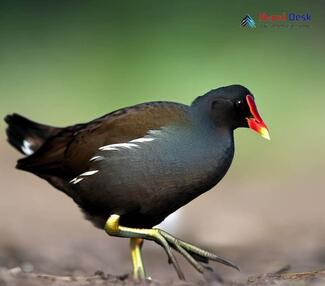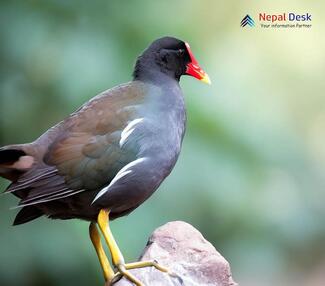Nepal, a treasure trove of biodiversity, boasts a vast variety of bird species that draw birdwatchers and nature enthusiasts from across the world. Among these captivating birds is the Common Moorhen (Gallinula chloropus), a fascinating, adaptable waterbird found in diverse wetland habitats throughout the nation, from lowland marshes to alpine lakes. In this blog post, we'll delve into the unique features of the Common Moorhen and its intriguing life in Nepal.
Adapting to Survive
The Common Moorhen flourishes in various wetland settings, such as marshes, lakes, swamps, and even rice paddies throughout Nepal. Its ability to adapt to different water depths and vegetation types contributes to its extensive presence. This medium-sized bird is adorned with dark plumage and features a striking red frontal shield and yellow-tipped beak that make it easily recognizable.
Concerning feeding habits, the Common Moorhen boasts an expansive diet consisting of plant material and small aquatic creatures like insects, larvae, and mollusks. This omnivorous nature allows the Moorhen to thrive in habitats with diverse food sources.
Breeding & Nesting
Between March and July, the Common Moorhen's breeding season takes place in Nepal. These birds form devoted pairs during this period, engaging in intricate courtship displays encompassing bowing and mutual preening. Once partnered up, couples team up to construct their nests using plant materials either in shallow waters or well-hidden spots within wetland vegetation.
Clutch sizes range from 5-8 eggs per breeding attempt, with both parents sharing incubation duties for 19-22 days. The chicks are precocial upon hatching – they're nearly instantly mobile and capable of leaving the nest. Despite their early autonomy, parent Moorhens continue to care for their young until they can fully fend for themselves.
Preserving Nepal's Wetland Wonder
While the Common Moorhen is not endangered nor classified as a threatened species, ongoing efforts to safeguard and maintain wetland habitats in Nepal are essential for their long-term survival. Nepal's government has established protected areas like Koshi Tappu Wildlife Reserve and Chitwan National Park, preserving significant wetland habitats.
To sum up, the Common Moorhen represents the diverse wildlife inhabiting Nepal's varied ecosystems. The bird's far-reaching distribution within Nepal's wetlands and adaptability to different environments demonstrate its resilience and robustness. As a country rich in natural beauty and an assortment of captivating creatures, Nepal offers endless opportunities for birdwatchers and nature enthusiasts to witness amazing avian displays, such as the enthralling Common Moorhen.




